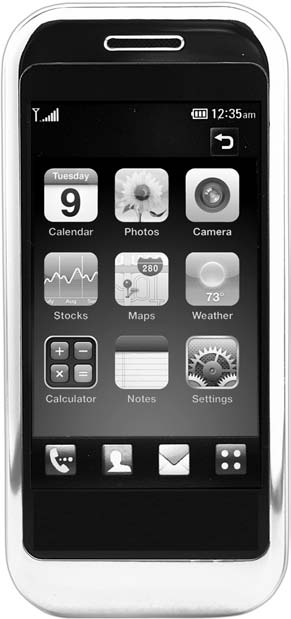The Buying Brain: Secrets for Selling to the Subconscious Mind (44 page)
Read The Buying Brain: Secrets for Selling to the Subconscious Mind Online
Authors: A. K. Pradeep
Tags: #Non-Fiction, #Psychology

Elsewhere in the brand, product, packaging, and in-store chapters you’ll find more best practices that in some instances also apply to advertising.
As you now know, one of the central themes of this book is a simple, straightforward, but exceptionally important concept: The brain is built to buy.
In fact,
the brain
wants
to buy
. Rather than the conventional wisdom that has informed some marketing and advertising thinking in the past, I encourage you to embrace that neurological knowledge and allow it to influence how you create advertising.
You still need to sell. But know that you don’t have an adversary inside your consumers’ heads—you have an amazing entity that is primed to receive and respond to your messaging.
P1: OTA/XYZ
P2: ABC
c16
JWBT296-Pradeep
June 9, 2010
17:33
Printer Name: Courier Westford, Westford, MA
218
The Buying Brain
I hope this book will help you create messaging that the brain finds the most appealing, interesting, attention-getting, involving, synchronized, ambiguous, emotionally engaging, momentarily puzzling, persuasive, and memorable. As consumers, we will all benefit if you do.
Takeaways:
r You now have a grasp of how neurological testing can provide
previously unobtainable research data
across all advertising mediums, and in extreme detail about individual components of specific ads.
r You’ve read how other companies have used brainwave activity measurements to improve the effectiveness of their advertising.
r You have a set of actionable best practices to apply to make your advertising the most neurologically effective it can be.
P1: OTA/XYZ
P2: ABC
c17
JWBT296-Pradeep
June 7, 2010
8:14
Printer Name: Courier Westford, Westford, MA
The Buying Brain, Screens,
and Social Media
At the end of this chapter, you’ll know and be able to use the
following:
r The critical differences in terms of consumers’ subconscious responses between viewing content and messaging on traditional TV, the Internet, and mobile platforms
r Why faces are so important across these three mediums r How to create the most effective video materials for each of the mediums r How to create the neurologically most powerful content for social networks
One of the most fascinating dichotomies of neuromarketing is this: we’re dealing with an organ that hasn’t changed for 100,000 years; and yet we’re measuring its responses to new technology appearing in the marketplace in the time frame of months, if not weeks.
A prime example is the three screens phenomenon. The word “phenomenon” gets tossed around all too readily, but in this case, it truly fits.
The scale of growth in any one of these three media—traditional television, the Internet, and mobile devices—is simply stunning. The modern world has never experienced anything like it. In fact, as this book goes to press, the
“three screens phenomenon” has morphed into something like the 15-screen phenomenon, and growing.
For those who regard TV as a mature medium, the figures say otherwise.
While I’ve stayed away from citing streams of statistics in this book, this is a category where the numbers tell the story better than words.
219

P1: OTA/XYZ
P2: ABC
c17
JWBT296-Pradeep
June 7, 2010
8:14
Printer Name: Courier Westford, Westford, MA
220
The Buying Brain
Total adult daily viewing time devoted to watching all screens: approximately
8.5 hours.
(That actually grows to
9.5
hours for viewers age 45–54.) TV viewing amounts to
98 percent
of viewers’ time devoted to watching video material on screens.
So the notion that “traditional” television is losing ground to alternative screen-based media is misleading. The whole pie is growing. As I like to say, the brain is a glutton. It can, and will, handle a bigger pie with ease.
Of course, the
“three screens” terminology is already inadequate
to describe our daily exposure to screen-borne messages. When you add: videos you encounter in the retail environment; back-of-the-seat entertainment in SUVs, taxicabs, airplanes, and so on; video feeds in medical office and pharmacy waiting rooms and even at gas station pumps; plus a host of other so-called “out of home” venues from bars to sports stadiums, the exposure level is striking.
But does the brain process all this moving image material the same way? The answer is no. Functionally, the brain
receives
video stimuli in an identical fashion, no matter the source. However, as with other aspects of neuromarketing, this finding is only part of the picture. There are marketing implications to be drawn from what we’ve learned about how the subconscious
responds
to video in various formats, from the JumboTron at the sports coliseum to the smallest cell phone screen in the palm of your hand. See Figure 17.1.
Figure 17.1
The world of three screens is already over.
Source:
Photo courtesy of Dreamstime.com P1: OTA/XYZ
P2: ABC
c17
JWBT296-Pradeep
June 7, 2010
8:14
Printer Name: Courier Westford, Westford, MA
Buying Brain, Screens, and Social Media
221
There are differences and those differences will become increasingly critical for marketers as the communications spectrum continues to splinter and expand, especially as mobile communications accelerate their share of our video viewing time. Marketers must differentiate their approach to using each motion-based medium to achieve optimal neurological impact and effectiveness.
Neuroscience already has tools designed specifically to address this need.
Right now, for example, we apply a unique technology known as
Neurological Compression
to render one form of video communications functional and effective for other, alternative formats.
The compression codec identifies, isolates, and edits together the most neurologically powerful scenes from material such as a TV commercial. A typical application would create a 10–12-second version of a 30-second spot.
This enables companies to take existing (usually expensive to produce) footage and run it in shortened lengths on the Internet or mobile devices, where such short video clips are the norm (and where longer-length clips are neurologically much less effective). The cost and time savings realized from this effective use of current materials are considerable. But the best payoff is being certain that the shorter messages have the greatest possible neurological impact. See Figure 17.2.
The Convergence Conundrum
Trends, especially technology-based ones, tend to take on a life of their own.
One of the more persistent ones—stimulated by the trinity of technological advances, manufacturer marketing, and consumer behavior—is the migration of Internet-based material to the living room TV set. So much has been forecast for this movement that, even though it has not yet happened on a large scale, it has long had the air of inevitability about it.
As interconnectivity becomes easier the boundaries between screens is beginning to drop away. Once connected, you can surf the Internet from your sofa as easily as on your 50-plus-inch high definition liquid crystal display (LCD) screen as you can on your wireless laptop, netbook, your smart phone, and your iPad. It’s already occurring as Internet access-equipped new TVs are penetrating showrooms and homes.
But there’s a hidden risk in that for marketers. And speaking from the perspective of the brain, it’s a big one.
If marketers believe that they can create one video production, run it across all video screens, and achieve the same messaging impact regardless of format they will be making a major mistake.

P1: OTA/XYZ
P2: ABC
c17
JWBT296-Pradeep
June 7, 2010
8:14
Printer Name: Courier Westford, Westford, MA
222
The Buying Brain
Figure 17.2
Mobile phone screens engage the brain differently
than other screens.
Source:
Photo by NeuroFocus, Inc.
Our research has shown that the brain responds to the presentation of certain
kinds of content quite differently on one screen size versus another.
Faces Are Fundamental
You will read elsewhere in these pages how the brain is designed to pay attention to faces. Our ability to discern emotion and intent is founded largely on our brain’s highly developed facial recognition capabilities.
P1: OTA/XYZ
P2: ABC
c17
JWBT296-Pradeep
June 7, 2010
8:14
Printer Name: Courier Westford, Westford, MA
Buying Brain, Screens, and Social Media
223
Why are faces so central to marketing campaigns on each of the three screens? For one very simple reason:
We need to be able to read someone’s face to extract data about their emotions and intent.
So what? So, I need to be able to see you clearly and directly to divine the unspoken messages you are conveying to me, and that my brain is acutely attuned to receive, analyze, and respond to. I also need to be able to look at your eyes (humans are the only animals with “the whites of the eyes,” or scleras), gauge the shape of your mouth, and scan your whole visage for any signs of your mood or your plans that I can glean.
I can do that just fine on my large-diameter high-definition flat screen in the relative peace and quiet of my living room. I can also manage that reasonably well—though not as finely—on my desktop or laptop computer. I may miss some fine detail, but I can still get the gist of what you’re all about.
But on my mobile device, I really can’t see your face in any detail at all. I can’t determine with reliable accuracy what your eyes have to tell me. You’re too small for my brain to decipher the full message your face is conveying.
“So,” you may be saying to yourself, “what’s your point?” “That faces don’t
‘play’ well on cell phones? Okay, understood. So what?”
So what is important to you, as a marketer or consumer, is that you want to send, or receive, marketing messages that capture your attention, engage your emotions, and merit retention in your memory.
Faces convey emotions. If I can’t see your face properly, I won’t pay attention to it. If I don’t pay attention, my emotions are not going to be engaged. If my emotions remain unengaged, I am not likely to remember you—or what message you are trying to send me.
What all this means for marketers is what our research has revealed: r For the brain’s purposes, faces play best on larger screens. Therefore, emotion-based messaging is best suited for large format video displays.
Target messages that rely at their core on evoking
emotional responses
to these larger-format devices.
r Target more
fact-based
messaging to smaller screens. This is not to say that fact-based commercials won’t play well on big screens—but they are well suited for smaller devices where consumers can retrieve and absorb data quickly and easily.
P1: OTA/XYZ
P2: ABC
c17
JWBT296-Pradeep
June 7, 2010
8:14
Printer Name: Courier Westford, Westford, MA
224
The Buying Brain
Put another way, there’s a downside to trying to convey emotionally laden content effectively on handheld screens, while there’s an upside to portraying them on large screens. Conversely, while there may not be a downside per se to trying to communicate fact-based messages on big screens, they match up more closely with how consumers actually use handheld/mobile devices—meaning short viewing times spent acquiring (or transmitting) brief bursts of data.
This basic alignment takes on more importance and urgency when you see viewing trend figures.
A recent study commissioned by the Council for Research Excellence and conducted by Ball State University revealed some compelling data (full disclosure here: the Council is sponsored by the Nielsen Company, which is a strategic investor in NeuroFocus).
